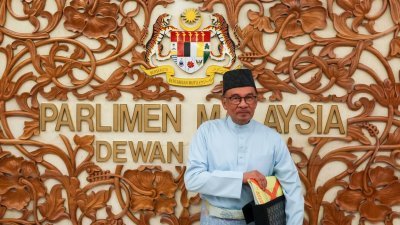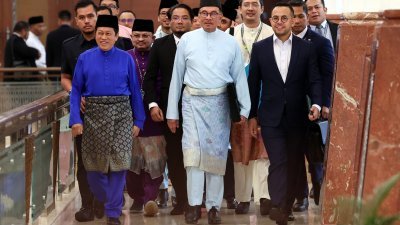纵观团结政府提呈的2023年的预算案,主要是维持现状,有部分是复苏经济,也有部分是选举导向,就像以前国阵政府的预算案一样,这不是改革派政府应有的预算。
首相兼财长安华在提呈预算案时指出:“问题是,(我们)是否有实现变革的政治意愿”。 他指出了国家面临的五大挑战:
●高债务水平
●行政素质低下
●全球不确定性
●投资增长缓慢
●人民经济困境
然而,财案似乎对这些挑战无所作为。反之,更多的是考量迫在眉睫的6州选举,革新和改革的言词很大程度上仍然是口号就不足为奇了。
很明显,安华提呈的财案,是基于前财政部长东姑扎夫鲁去年10月在第15届大选之前提出的原本2023年财案的模板——这主要是倾向于马来人和公务员的表面改革,没有展示出任何改革的政治意愿。
这是1997年之后,安华提呈的第一份预算案,也是马来西亚历史上最大的预算案。但更大并不一定更好,尤其是当这导致公务员体制进一步膨胀,而几乎又没有带来实质的治理和体制改革措施时。
财案的总支出为3861.4亿令吉,其中1455亿令吉用于公务员薪金和运营开支,586亿令吉用于津贴,而只有970亿令吉供发展开支。 其他为退休金(300亿令吉)、债务利息(459.4 亿令吉)、各州款项(81亿令吉)。
总收入则为2915亿令吉,其中包括2182亿令吉的税收收入和733亿令吉的非税收入,因此预算赤字包括由官联公司付款组成的部份为
946亿令吉。
公积金体制也没有任何改革,只有一些象征式援助,即存款馀额低于1万令吉者,将获得500令吉补助。尽管,马来西亚许多人面对著退休危机,然而依然不见任何税制改革,只见B40群体(低下阶层)的税率降低了2%,而T20(高收入)群体的税率将提高2%。如果不进行改革,政府的未来税收将面对问题。
预算案内也缺乏希盟和国阵承诺的收入安全网。政府给予社会援助的80亿令吉拨款,除于受惠的870万人,每人等于每年只有920令吉。 一名工会领袖就斥为这是“微不足道的一次性施舍”。财案没有提出一个全方位的方案,以改善B40和M40群体面对著的低收入困境。
对中小企业的援助主要还是以贷款形式,并给予发展自动化优先关注。这肯定会带来交付和管理问题。毕竟,政府标准可能过于严格,使许多中小企业不符合资格。
尤其分配给自动化和数码化的拨款很可能无法用完,因为大多数中小企业只是“勉强维持营运”,无法符合拨款的要求。“关系”往往可决定谁可获得援助。税务优惠对没有盈利的中小企业作用不大,许多中小企业目前在技术上已经资不抵债。国库控股和公积金局 斥资15亿令吉于创新和高增长初创公司的投资计划,很可能只惠及富裕和有关联的公司。大部分资金也可能是用于谘询服务。
从政府提供10亿令吉的贷款和税收优惠,到国家稻米公司把进口米业务的30%利润与稻农分享,这些都无助于提高粮食生产。农业企业也可能不会充份善用技术补助金,或者最终可能流向虚假的政治关联公司。财案几乎没有采取任何措施来降低粮食生产成本,如降低农业生产工具的入口税。反之许多食品仍然有进口准证(AP)限制,这导致了人为的高成本。
建议设立特攻队推动政府机构的改革和革新,是朝著提高政府效率的正确方向迈出了一小步。但这应该扩大到更广的层面,从部门到下面的分局每一阶层,检视哪一方面出现人员臃肿和低效率情况,并在下一个财案前采取必要的纠正行动。
预算案其中一项令人关注的是,做为财长的安华,财政部拨款从298.7亿令吉增加到672.4亿令吉,增加了125.1%。这是一个庞大的数额,将增强财政部的权力。
政府预测2023年的津贴总额为586亿令吉。其中许多补贴,例如为稻农提供的18亿令吉补贴,将只会令我国水稻产业继续保持低效率。同样,给予18-20岁青少年的200令吉补贴,也是一种浪费,这不是帮助这些人增强自己的能力的方法。
官联公司为青少年、技职教育毕业生、退伍军人和其他弱势群体提供3万5000个新工作机会,只会令这些机构更加低效率。这份新的优惠清单可能会带来短期政治收益,但在经济回报上,很大程度上是虚幻的。
首相承诺分享“真实事实”,而不是选择“迷人”的数字来准确呈现国家状况,然而安华却错失了预算案这个良机。
(本文章是作者与Ramesh Chander和Murray Hunter共同撰写。)
林德宜《2023预算案──同样的旧东西》原文:
Budget 23: Same Old Stuff
Mainly status quo, part recovery, and part election oriented, the 2023 budget was like previous Barisan Nasional budgets rather than one by a reformist government.
In his budget presentation, the Prime Minister had asked: “the question is whether there is political will to effect change”. He noted five challenges facing the nation:
high debt level
low quality of administration
global uncertainties
slow investment recovery
rakyat economic woes.
However little appears to be done with these challenges. Crafted with the looming state elections in mind, it is not surprising that the rhetoric of change and reform has largely remained rhetoric.
It is clear that what has emerged is based on the original 2023 template presented by former finance minister Tengku Zafrul last October before GE15 - that is mainly cosmetic reform geared towards the Malay and civil service constituency and with no evidence of political will to change.
Anwar’s first full budget since 1997 is the largest budget presented in Malaysia’s history. But bigger is not necessarily better especially when it results in further bloat of the public service and with little evidence of substantive institutional and governance reform measures.
Total forecast spending is RM 386.14 billion, of which RM 145.5 billion is spent on salaries and operating expenses, RM 58.6 billion in subsidies, while RM 97 billion is planned spending on development. The balance is on retirement charges (RM 30 billion), debt service charges (RM 45.94 billion), payments to states (RM 8.1 billion).
This will be financed by RM 291.5 billion in revenue, made up of RM 218. 2 billion in tax revenue, and RM 73.3 billion in non-tax revenue, with a budget deficit made up from borrowings and payments from GLCs of RM 94.60 billion.
Disappointment with more of the status quo
There are no reforms undertaken on the EPF system, only some token assistance where balances under RM10,000 will receive an RM 500 top up. This is even though there is a retirement crisis in Malaysia. Likewise, rather than any tax reform, there will be a 2 percent decrease in tax rates for the B40 group, and an up to a 2 percent tax rise in the T20 group. Taxation revenue will become a crucial issue for future governments, if reform is not undertaken.
The budget fell well short of the income safety net promised by both Pakatan Harapan and Barisan Nasional. The social assistance allocation of RM 8 billion to cover the needs of 8.7 million people will amount to RM 920 per person per annum. THis has been dismissed as “paltry, one off handouts” by a senior trade union official. No change is forthcoming on a holistic approach to rectify the fundamental issue of low wages that continues to hold back the B40 and M40 income population.
SMEs Again Neglected
Assistance to SMEs will largely be in loans, with priority to developing automation. There will definitely be delivery and management problems. Government criteria may be too tight, making many SMEs ineligible.
The funds allocated for automation and digitalization, may not all be taken up, due to most SMEs being only ‘hand to mouth’ operations and not able to match grants. “Know who” will decide who gets assistance. Tax incentives will be of little use to SMEs which have not been able to make profits, Many SMEs are presently technically insolvent. There is a risk that the Khazanah Nasional and EPF innovative and high-growth start-up companies RM 1.5 billion investment scheme will benefit only wealthy and connected companies. Much of the money will also go towards consultancy services.
Food security
Bernas sharing 30 percent of net profits on rice imports, offering RM 1 billion in loans and tax incentives is not going to assist in enhancing food production. Technological grants for private investments may not be fully taken up by farming enterprises or may end up going towards sham politically connected companies. Little is being done to lower the cost of production, through decreasing input duties on farm inputs. There are still APs in place on food items, which is contributing to artificially high costs.
The key forgotten reform
The proposal to set up a special task force to reform government agencies is a small step in the right direction for enhancing the efficiency of government. This should be expanded to a full study of government, from ministries down to agencies, to determine where bloated staffing levels and inefficiencies exist and where necessary action can be taken to cut back before the next budget.
One interesting aspect of this budget is that the finance ministry, of which Anwar is minister, had its allocation of RM29.87 billion raised to RM 67.24 billion, a rise of 125.1 percent. This is a massive increase, enhancing the power of the finance ministry over the government. The government has forecast RM58.6 billion in subsidy payments for 2023. Many of these subsidies, such as RM 1.8 billion for rice farmers will continue to ensure that the paddy industry remains inefficient. RM 200 to be paid to youths between 18-20 will just be wasted and not assist these people to empower themselves. CLGs offering 35,000 new job opportunities to youth, TVET graduates, veterans, and other vulnerable groups is just going to add to the inefficiencies of these organizations. This new laundry list of giveaways may provide short term political gain but the economic returns are largely illusive.
The Prime Minister had promised to share “the real facts” rather than opting for “captivating” figures to accurately present the state of the nation. The budget presentation was a missed opportunity.
This article was co written with Ramesh Chander and Murray Hunter
要看最快最熱資訊,請來Follow我們 《東方日報》WhatsApp Channel.








.jpeg/01832cd23f4a2fce0dad6bed4a9e7b8b.jpeg)









